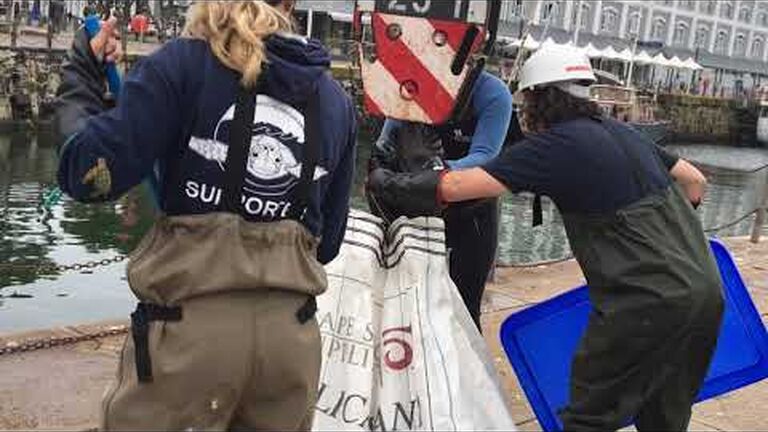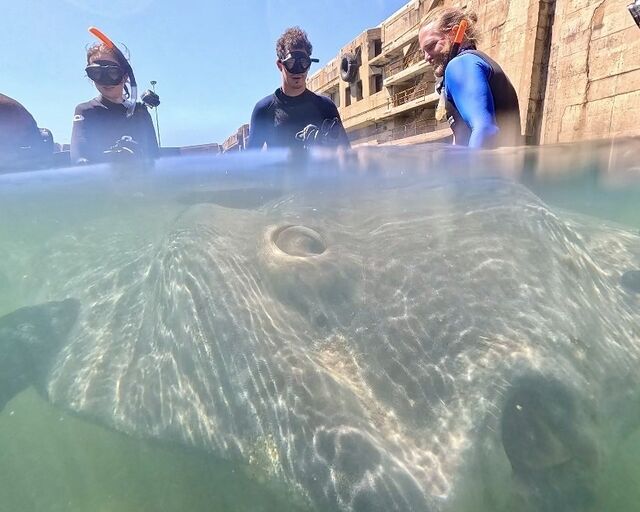Late on 7 December, the Two Oceans Aquarium Foundation was alerted to the fact that approximately 20 seals were trapped in the dry dock across from the Aquarium. The dry dock had been open and filled with water for quite some time and in the last week or so large numbers of fish were aggregating in the harbour. The seals had been feasting on the fish in the dry dock, when it was closed and the water drained. Having seals trapped in these dry docks, as the water is pumped out, is not something new, and the Aquarium has assisted and rescued quite a few of these animals over the years. But having 20 or so in there, at the same time, was new for everyone involved.
It was decided to mount a mammoth rescue mission starting on the morning of 8 December. Staff members from both the Aquarium and the Aquarium Foundation gathered at the dry dock for a briefing. The plan of action was explained and amounted to each seal being caught in a special coned-net, measured, sexed, tagged, a weight estimate made, and a whisker being taken (for DNA purposes). Each seal would then be transferred to a large transport bag, which would be hoisted out of the dry dock by a crane, the use of which, as well as the operator’s time, was very generously donated by the amazing Johnson Crane Hire. Each seal was hoisted all the way onto the harbour wall where another team released the seal and sent it on its way, back into the open water of the harbour.
The seals had made themselves very comfortable on the one side against the dry dock wall. They were piled in a neat heap of blubber and fur. The “catching” team made their way down into the dry dock, armed with seal-guiding-sticks, the catching net, and all the supplies needed to get the job done, while the second team, the release team, stayed topside to wait for the first seal to be delivered by crane. A quick count established that there were at least 28 seals to be rescued.
The seals ranged in size from two very small ones, with the majority being medium-sized, and some even hitting the “very large” scale. Irrespective of their size, they all gave the rescue team quite the run-around. Once a seal was caught, it then had to be restrained. This involved something as simple as just holding the seal (honestly, there were only two that were small enough to do this with), to having five or six people holding the animal while the necessary measurements were taken and the seal was tagged. It is vitally important for these procedures to be followed as the tags will assist us in identifying the seals in the future. Having their measurements and estimated weight will also assist in monitoring their health.
After all the data was collected, the next step was to remove the seal from the coned net and place it into the large transport bag. This proved to be quite a tricky part of the rescue as seals do not enjoy having their bums manoeuvred in a reverse motion. And remember – these are wild animals. They will defend themselves if feeling threatened and, in this situation, they were ever-ready to do just that. Both the “catching” team as well as the “release” team had to be on their guard at all times, ready to react in an instant.
With the seal safely secured in the transport bag, the crane then kicked into action, hoisting the seal out and over, depositing it near the harbour’s edge. Here, the release team now had their hands full with a seal that had been caught, examined, flown through the air, and that was now definitely ready to get out of the confines of the bag and into the harbour as quickly as possible. Added to that, by the time the first seal had been caught, quite a number of onlookers had gathered. It was therefore imperative that the release team be ready with their guiding sticks to ensure that the seal headed for the water, and not towards the public. From the release point on top of the harbour wall, it is a fairly long jump down into the water, but seals are masters of diving acrobatics, and the drop into the water is nothing that they haven’t done hundreds of times before.
The process was repeated 12 times on the first day, with 13 seals rescued in this manner. The two small pups hitched a ride together in the bag. By about 13h00, the sun and high adrenalin had started taking their toll not only on the rescuers, but the heat and stress were also starting to get to the seals that were still trapped in the dry dock. It was decided to let the animals be and give them time to de-stress and relax until the next morning. This would also give the rescuers time to regain their strength and start the process afresh.
On the morning of 9 December, the teams switched gears and decided to try and herd the remaining seals out of the dry dock, up the stairs and over the quayside. They divided the remaining seals into groups of five and got to work. The seals complied and the operation concluded with all the seals being returned to the open water of the harbour, concluding an incredibly successful, mammoth rescue!
The Two Oceans Aquarium, the Two Oceans Aquarium Foundation, with the V&A Waterfront Wildlife Management Programme monitors, are no strangers to rescuing seals and sunfish from the dry docks. The teams have done this before and they know what behaviours to look out for when working with these animals. Under no circumstances should anyone, other than these professionals, attempt this. Seals are wild animals, and like any wild animal, will react to a threat in such a way as to protect themselves. In the case of seals, their first line of defence is to charge at the threat and bark loudly. After that, if they are still feeling threatened, they will bite to defend themselves. You certainly do not want to be on the toothy-side of a 100kg+ seal! They can inflict nasty wounds and their mouths are teaming with some choice bacteria. A seal bite can get very badly infected. This and the fact that wild animals should generally just be left alone, are enough reasons to leave any rescues or assistance given to these animals, to the professionals.
We cannot thank Johnson Crane Hire enough for their help with these rescues. Johnson Crane Hire has gone out of their way to assist us by making a crane and crane operator available whenever we have needed one. This mammoth rescue would have involved each individual seal being carried out of the dry dock, one at a time, if the crane was not available. It is incredibly heart-warming to know that people and companies want to help animals in need, and in this case, a crane was needed, and provided by a great company. Thank you!





